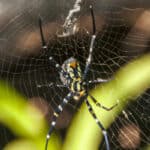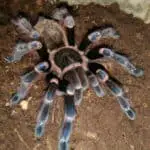Jumping spiders are fascinating creatures that are known for their incredible jumping ability and unique behavior. One of the most interesting aspects of jumping spiders is their molting process, which is the shedding of their exoskeleton to allow for growth. But how long does it take a jumping spider to molt?
According to research, the molting process for jumping spiders can take anywhere from a few minutes to several weeks, depending on the age and size of the spider. Young jumping spiders tend to molt more frequently and quickly, with some spiderlings and juveniles molting every few weeks. Adult jumping spiders, on the other hand, may take several hours or even up to a week to complete the molting process.
Understanding the molting process of jumping spiders is important for their overall health and well-being. In this article, we will explore the life cycle of a jumping spider, factors that influence molting, and how to protect jumping spiders during the molting process. Let’s dive in!
Key Takeaways
- The molting process for jumping spiders can take anywhere from a few minutes to several weeks, depending on the age and size of the spider.
- Young jumping spiders tend to molt more frequently and quickly, while adult jumping spiders may take several hours or even up to a week to complete the process.
- Understanding the molting process of jumping spiders is important for their overall health and well-being, and we will explore this in more detail in this article.

Understanding Jumping Spider Molting
As a pet owner of a jumping spider, understanding the molting process is crucial for the health and well-being of your furry friend. Molting is the process of shedding the old exoskeleton and growing a new one.
The molting process of a jumping spider can take anywhere from a few minutes to up to three weeks, depending on the age and size of the spider. Juvenile jumping spiders typically molt faster, while sub-adult spiders take longer.
Before molting, jumping spiders go through a pre-molt stage where they store up enough energy to begin the molting process. During this stage, they will create a thick web sack where they will molt.
Once the spider enters the molt stage, it will shed its old exoskeleton and grow a new one. The molting process is a vulnerable time for the spider, and it is crucial to ensure that the environment is suitable for a successful molt.
After molting, the spider will need time to harden its new exoskeleton and recover from the process. This post-molt stage is just as important as the pre-molt and molt stages and should not be overlooked.
In conclusion, understanding the molting process of a jumping spider is essential for their health and well-being. By providing a suitable environment and ensuring a successful molt, you can help your furry friend thrive.
Life Cycle of a Jumping Spider
Jumping spiders are fascinating creatures with a unique life cycle. In this section, I will discuss the different stages of a jumping spider’s life cycle, from spiderlings to adults. I will also cover the molting stages that are crucial to their development.
From Spiderlings to Adults
Jumping spiders begin their life cycle as spiderlings, which are tiny and vulnerable. During this stage, they depend entirely on their mother for survival. After hatching from their eggs, spiderlings remain in their mother’s care for a few days until they are ready to venture out on their own.
As spiderlings grow, they shed their skin through a process called molting. This shedding allows them to grow and develop new body parts. After several molts, they reach maturity and become adult spiders.
Molting Stages
Molting is a critical stage in the life cycle of a jumping spider. During this stage, the spider sheds its old exoskeleton and grows a new one. This process can take anywhere from four days to a month to complete, depending on the spider’s age and species.
Before molting, spiders go through a pre-molt stage, during which they become less active and eat less. Once they are ready to molt, they spin a silk mat and attach themselves to it. They then shed their old exoskeleton and emerge with a new, shiny one.
After molting, spiders enter a post-molt stage, during which their exoskeleton hardens and they become more active. Juvenile spiders molt more frequently than adult spiders, as they need to grow and develop quickly.
Conclusion
In conclusion, the life cycle of a jumping spider is fascinating and unique. From spiderlings to adults, these creatures go through several stages of development, shedding their exoskeletons and growing new ones. As a breeder or owner of a jumping spider, it is essential to understand their life cycle and provide them with the care they need to thrive.
Factors Influencing Molting
As with any biological process, there are several factors that can influence how long it takes a jumping spider to molt. In this section, we will explore some of the most important factors that can impact the molting process.
Role of Nutrition
One of the most important factors that can influence how long it takes a jumping spider to molt is nutrition. Jumping spiders need a balanced diet that includes a variety of feeder insects, such as crickets, mealworms, and dubia roaches. Feeder insects should be gut-loaded with a nutritious diet before being offered to the spider. Additionally, feeding schedules should be consistent to ensure that the spider is getting the nutrients it needs to molt successfully.
Importance of Hydration
Another important factor that can impact the molting process is hydration. Jumping spiders need access to water at all times, either through a water dish or regular misting. Low humidity levels can lead to dehydration, which can cause the molting process to take longer or even fail altogether. It is important to maintain appropriate humidity levels in the spider’s enclosure to ensure that it stays hydrated.
Environmental Conditions
Finally, environmental conditions can also play a role in how long it takes a jumping spider to molt. Jumping spiders prefer warm, tropical environments and require appropriate lighting, such as LED lights, to thrive. The temperature and humidity levels in the spider’s enclosure should be monitored closely to ensure that they are ideal for the spider’s species and size. Additionally, it is important to provide appropriate hiding spots and other elements of a natural habitat to keep the spider comfortable and reduce stress.
By paying attention to these factors and providing a suitable environment for your jumping spider, you can help ensure that it molts successfully and in a timely manner.
Behavior During Molting
As a pet owner, observing the behavior of your jumping spider during molting can be an exciting but nerve-wracking experience. In this section, I will discuss the different behaviors you may observe in your spider during the pre-molt, during molt, and post-molt stages.
Pre-Molt Behavior
Before molting, jumping spiders usually become less active and may retreat into a pre-molt web. During this time, it is important to disturb them as little as possible and to ensure they have enough energy reserves to complete the molting process successfully. You can do this by not putting any feeders in and continuing to mist the enclosure to maintain humidity levels.
During Molt Behavior
During the molt, you may notice that your spider becomes completely still and unresponsive. This is because they are shedding their old exoskeleton and forming a new one. The duration of the molting process can vary between individuals and species, with some spiders molting in minutes and others taking several hours or even a week or more.
It is important to note that during this time, your spider is vulnerable and fragile. You should avoid disturbing them and ensure that the enclosure is kept at the appropriate temperature and humidity levels. You can also provide a molt mat or other soft surface for them to rest on during the process.
Post-Molt Behavior
After molting, your spider may appear weak and disoriented. They may also be more vulnerable to stress and illness during this time. It is important to continue to provide a stress-free environment and monitor them closely for any signs of illness or injury.
In conclusion, observing the behavior of your jumping spider during molting can be a fascinating experience. By understanding their pre-molt, during molt, and post-molt behaviors, you can ensure that your spider successfully completes the molting process and remains healthy and happy.
Physical Changes and Appearance
When a jumping spider molts, there are several physical changes and appearance alterations that occur. In this section, we will discuss the most noticeable changes that take place during the molting process.
Color and Pattern Changes
One of the most noticeable changes that occur during the molting process is the change in color and pattern. Juvenile jumping spiders tend to have brighter and more vibrant colors than adult jumping spiders. During the molting process, the spider’s old skin is shed, revealing a new, brighter and more vibrant color pattern.
Body and Leg Changes
The molting process also involves changes to the spider’s body and legs. During the molting process, the spider’s old skin is shed, and a new, fragile skin is revealed. The spider’s new skin is soft and vulnerable, making the spider more susceptible to injury. The spider’s legs also undergo changes during the molting process. The spider’s legs become longer and thinner, allowing the spider to move faster and more efficiently.
Overall, the molting process is an essential part of a jumping spider’s life cycle. It enables the spider to grow and develop into a healthy adult. By shedding its old skin and revealing a new, vibrant color pattern, the jumping spider can continue to thrive in its environment.
Protecting Jumping Spiders During Molting
As a pet owner, it is important to ensure that your jumping spider is safe and comfortable during the molting process. Molting is a vulnerable time for spiders, and they need a safe space to molt without the risk of predation or other dangers. In this section, I will discuss how to protect your jumping spider during molting.
Creating a Safe Space
Creating a safe space for your jumping spider to molt is crucial. During the molting process, spiders are at their most vulnerable, and they need a secure area where they can molt without the risk of injury or predation. Here are some tips for creating a safe space for your jumping spider:
- Provide a hammock or web sack: Jumping spiders like to molt in a hammock or web sack. These provide a secure and stable surface for the spider to rest on during the molting process.
- Create a nest: You can also create a nest for your spider to molt in. This can be made from a small box or container with a lid. Make sure the lid has air holes so the spider can breathe.
- Use thick webbing: Jumping spiders will often create a thick webbing around their molting area for added protection. You can encourage this behavior by providing your spider with a suitable surface to create their webbing on.
Preventing Predation
Predation is a major risk during the molting process. Spiders are unable to move or defend themselves during this time, making them easy targets for predators. Here are some tips for preventing predation during the molting process:
- Keep pets away: If you have other pets in the house, make sure they are kept away from your jumping spider during the molting process. Dogs and cats, in particular, can be a danger to spiders.
- Remove pests: Pests such as ants and cockroaches can be attracted to the molting area and may pose a threat to your spider. Keep the area clean and free of any potential pests.
- Avoid disrupting the molting process: It is important not to disrupt the molting process. Avoid handling or moving the spider during this time, as this can cause stress and potentially harm the spider.
By following these tips, you can help ensure that your jumping spider molts safely and without any issues. Remember to always prioritize the safety and well-being of your pet spider during the molting process.
Further Research and Studies
While there is some information available about the molting process of jumping spiders, there is still much to be learned. Researchers are continually studying these fascinating arthropods to learn more about their behavior, biology, and physiology.
One study conducted by Harvard researchers found that jumping spiders can identify biological motion cues, making them one of the most visually adept of all arthropods. The researchers suspended the spiders above a spherical treadmill and observed their behavior to test their ability to recognize biological motion.
Another study conducted by former Harvard researchers analyzed infrared footage of juvenile jumping spiders and found evidence of a rapid-eye movement (REM) dream-like state during sleep. This discovery is particularly interesting because juvenile spiders have translucent exoskeletons, making it easier to observe their behavior.
One species of jumping spider that has received a lot of attention from researchers is the regal jumping spider. These spiders are known for their distinct coloring and impressive jumping abilities. Researchers have studied the behavior of regal jumping spiders to learn more about their communication methods and mating rituals.
As researchers continue to study jumping spiders, we can expect to learn more about their behavior, biology, and physiology. These studies will help us better understand these fascinating arachnids and the role they play in their ecosystems.
Frequently Asked Questions
How long does it take for a jumping spider to molt?
The molting process for jumping spiders can vary depending on their age and size. Typically, juvenile jumping spiders can molt in a few hours, while sub-adult jumping spiders can take up to three weeks to molt. However, the molting process can be affected by various factors such as temperature, humidity, and diet.
What are some signs of a jumping spider entering the molting process?
Before the molting process, jumping spiders usually enter a pre-molt stage where they become less active and may stop eating. During this stage, you may notice that your jumping spider is making a thick web sack or nest where it will molt. Once the spider has entered the nest, it will shed its exoskeleton and emerge as a new spider.
How can I help my jumping spider during the molting process?
It is important to provide a stress-free environment for your jumping spider during the molting process. Make sure that the temperature and humidity levels are suitable for your spider’s species, and avoid disturbing the spider while it is molting. You can also provide your spider with a small water dish to prevent dehydration.
What should I do if my jumping spider gets stuck in the molting process?
If your jumping spider gets stuck during the molting process, it is important not to intervene immediately. Give the spider some time to try and free itself. If the spider remains stuck for an extended period, you can gently mist the web sack with water to help soften the exoskeleton. If the spider is still stuck, seek advice from a veterinarian or an experienced spider keeper.
What are some common reasons for jumping spiders to die after molting?
Jumping spiders are vulnerable to various health issues after molting. Some common reasons for jumping spiders to die after molting include dehydration, stress, and infection. It is important to monitor your spider closely after molting and seek veterinary care if you notice any signs of illness.
How often do jumping spiders molt?
Jumping spiders typically molt every three to four weeks. However, the frequency of molting can vary depending on the spider’s age, size, and diet. Younger spiders, such as spiderlings and juveniles, may molt more frequently than older spiders.








